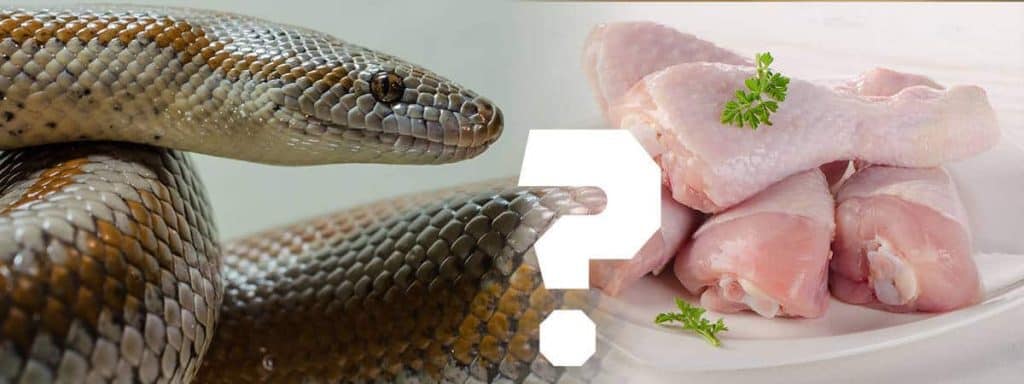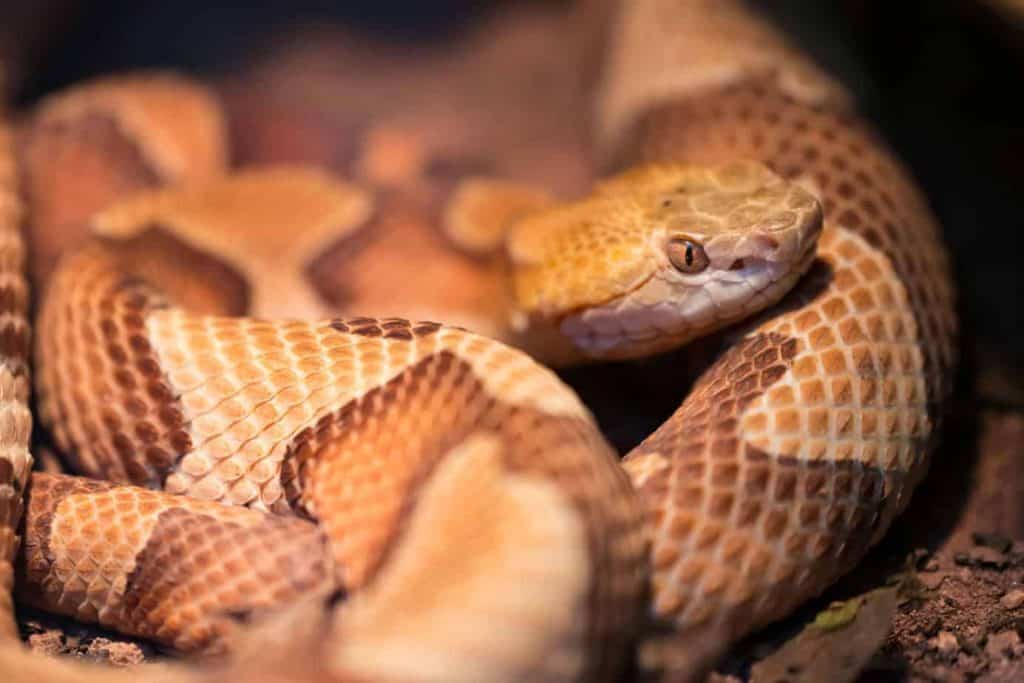Can Pet Snakes Eat Chicken?

Snakes Eat Chicken!? As an owner of chickens, a lover of the fried variety, and an avoider of snakes, I would never have imagined that my interests would collide in such a question. I dove into the internet to find out if pet snakes and I could dine together on one delicious roasted chicken.
Can pet snakes eat chicken?
The best source of food for any pet snake are small rodents, not birds. However, in a pinch, it is perfectly okay to feed your snake a few slices of raw chicken breast.
There are many dietary substitutions for snakes, but you should know that no snakes are vegetarian. Pet snakes do eat very differently than snakes in the wild, and snakes that you capture to keep in your house will have a little trouble adjusting to whatever you feed them.
The Typical Diet of a Snake in Captivity Usually Doesn’t Include Chicken
The food your snake needs depends entirely on what kind of snake you have.
Some snake breeds are capable of not only eating pre-killed mice but also baby chicks or chicken breasts every so often.
A smaller snake, like a garter snake, will eat insects. These could include cockroaches, crickets, slugs, earthworms, or insect larvae. They will also eat small fish and lizards, and tadpoles. In fact, I recently wrote a post just on garter snakes and their diet, where I outline the what, where, and how to feed your garter snake. Find it here.
“A good general food to feed your snake, no matter what kind, is a mouse. “
Bigger snakes like water snakes will eat fish, frogs, and other amphibians. Even bigger snakes like pythons and king snakes will eat even larger mammals like rabbits, rats, and mice. Eggs are another favorite of snakes in the wild. Really, really big snakes like the green anaconda will even crush wild pigs and swallow them whole.
A good general food to feed your snake, no matter what kind, is a mouse. The best kind is a pinky mouse, which is a newborn mouse with no hair. These come in all sizes, so you can even feed baby snakes extra small pinkie mice.
Snakes need this diet because it provides them with the best nutrients.
There are commercial reptile foods you can use as a substitute, but they often fail in giving a snake everything it needs.
The Nutritional Value of one 300 gram rat is as follows: 648 Calories, 63 grams of protein, and 33 grams of fat.
Snakes need all that protein in order to continue to function well.
Mice and rats are also what snakes typically eat in the wild, so it is the most natural diet for them. They will feel better, be more active, and live longer. Not to mention, feeding your snake whole mice is as natural as it gets. There are no preservatives or chemicals that might harm your pet. But what about feeding your pet snake wild mice? Here, you can find an article I wrote about whether or not pet snakes should eat wild mice.

Chicken Isn’t the Best Long-Term Substitute for Non-Rodent-Eating Snakes
If you’re still feeling squeamish, never fear. There are snakes out there that you can keep as a pet that
Garter snakes are very common, and they eat a wide variety of foods, so they might be the snake for you. Like I said earlier, garter snakes eat a lot of insects, like crickets and cockroaches.
They also eat fish, tadpoles, and earthworms. Many people object less to this kind of diet.
This rough and smooth green snake is a
If you are feeding your snake on a diet of just insects or invertebrates, make sure you keep it varied. Snakes need all the nutrients they can get, and a varied diet, especially for snakes that eat smaller prey, is a good way to achieve that.
Feed your pet every five days or so if you’re feeding them fish, and about twice a week if you’re going the insect route. Recently, I wrote an article answering the question of whether or not there were snakes that couldn’t eat mice. Find it here.
Snakes Wouldn’t Normally Eat Chickens in the Wild
A snake’s diet in the wild will be more varied than in captivity. Snakes in the wild tend to just eat whenever they find food because they’re not sure when the next time they’ll be able to eat is.
This means that a snake might eat insects, invertebrates, small rodents, and/or eggs. Bigger snakes will eat bigger meals. So a snake’s diet is fairly varied, but not to include chickens except in very rare circumstances.
In captivity, a snake will come to expect feeding times and adjust itself accordingly. It will become more active in the day leading up to feeding time, and will “hunt” along the perimeter of the enclosure.
If you capture a snake from the wild and keep it as a pet, it will have a little bit of a hard time adjusting to its new diet. The mice it ate in the wild were typically brown, so that’s what they are expecting. However, the frozen mice that you can buy are most often white. The snake might initially refuse to eat a white mouse because that is not what they are used to.
If your snake won’t eat, here’s a few things you can try:
- Introduce live prey. You want to do this with caution, as live prey can seriously injure your snake.
- Make sure your prey is thawed before giving it to your snake. They will not be excited about eating something cold or frozen and it could hurt their digestive systems.
- Warm up the enclosure. Often times if snakes are too cold, they will conserve energy and put off hunting.
- Feed them a mouse instead of a rat, or visa
versa . If a snake is used to one type of rodent, they might refuse another type. - Similarly, feed them a brown mouse instead of a white mouse. If they’re used to brown mice, that’s what they’ll prefer.
- Move the prey around the enclosure periodically to mimic a live prey. This can trigger a snake’s hunting instinct.
- Cut open the prey so the snake can smell blood.
Reptilinks and Supplements
Reptilinks offers “cased” foods. These are links made of a mixture of many different kinds of meat, like rabbit, chicken, insect, and frog. As stated earlier, snakes prefer foods closest to what they would hunt in the wild, so it may to a little difficult to get them to eat it.
Although this is an appealing solution, commercial reptile food has been shown to be lacking in all the right nutrition that snakes need to be healthy. If you’re set in using them, then I would suggest you also include supplements in the form of vitamins for your pet.
Calcium is going to be one the of the big ones that your snake will be missing. If in liquid form, you can add some calcium to their water, just a little bit every time you change out the water. Or if in solid form, you can put it inside whatever food you are placing inside the snake’s enclosure.
Make sure not to give them too much calcium at once. Too much calcium can neutralize stomach acids that are important in digestion.
Phosphorus is also a big one that your snake will be missing. It is generally best to do a 2-to-1 ratio of calcium to phosphorus when supplementing for your snake.
By far the most important nutrient your snake will be
If your snake newborn is lethargic, simply placing their terrarium on a window sill might help. Or getting a light bulb that emits really good UVB rays will also help your snake.
Supplements might not always be the best answer, but it is an option out there if you fear that your snake is not getting the right amount of nutrition.
Related Questions
Can snakes eat cooked chicken mea?
Snakes do not eat cooked meat because they always kill and swallow their prey whole in the wild. Snakes are picky eaters. It’s best to stay as natural as possible when it comes to keeping a pet snake.
Do snakes eat plants?
Snakes do not eat plants on their own. However, they do eat animals who eat plants, and they do benefit extremely from the contents of their prey’s stomach. But do not try to feed your snake straight plant matter.
